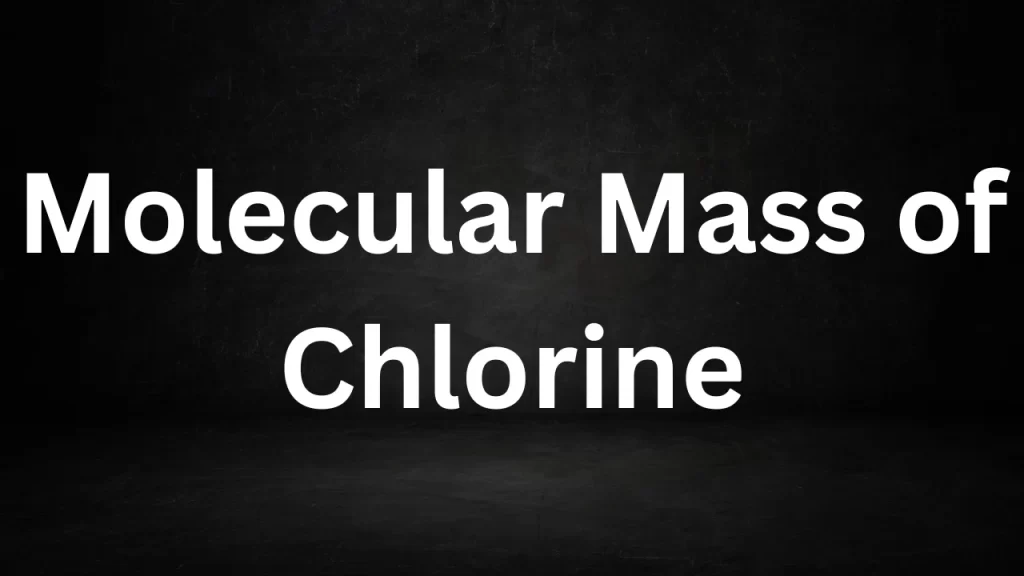Tag: Molecular Mass of Chlorine
Molecular Mass of Chlorine
Molecular Mass of Chlorine: Chlorine is a chemical element with the symbol “Cl” and the atomic number 17. It is a vital element in chemistry and plays crucial roles in various aspects of our lives, from disinfecting swimming pools to serving as a feedstock in the production of plastics and chemicals. To understand the properties and applications of chlorine, it’s essential to explore its molecular mass or atomic weight.

Molecular Mass of Chlorine
Chlorine’s Atomic Structure
Before diving into the molecular mass of chlorine, let’s take a brief look at its atomic structure. Chlorine has 17 electrons, arranged in three energy levels. Its atomic mass is approximately 35.45 atomic mass units (amu). It has two stable isotopes: chlorine-35 (about 75% abundance) and chlorine-37 (about 25% abundance), which contribute to its average atomic mass.
Molecular Mass vs. Atomic Mass
It’s important to distinguish between atomic mass and molecular mass. Atomic mass refers to the mass of a single atom of an element, while molecular mass (also known as molecular weight or molar mass) is the mass of a molecule, which is composed of two or more atoms. In the case of chlorine, it naturally exists as a diatomic molecule, Cl2, in its elemental form. To calculate the molecular mass of chlorine (Cl2), we add the atomic masses of the two chlorine atoms.
Calculating the Molecular Mass of Chlorine (Cl2)
To determine the molecular mass of Cl2, we need to consider the atomic masses of the chlorine atoms.
- The atomic mass of chlorine-35 (the more abundant isotope) is approximately 35.45 amu.
- The atomic mass of chlorine-37 is approximately 36.45 amu.
Now, we can calculate the molecular mass of Cl2:
Molecular Mass of Cl2 = (2 × Atomic Mass of Cl)
M – Cl2 = (2 × 35.45 amu)
Molecular Mass of Cl2 ≈ 70.90 amu
Therefore, the molecular mass of chlorine gas (Cl2) is approximately 70.90 atomic mass units (amu).
Significance of Mole Mass of Chlorine
Understanding the molecular mass of chlorine is important for various reasons:
- Chemical Reactions: It helps chemists predict the stoichiometry of reactions involving chlorine. For example, when chlorine gas reacts with sodium metal, it forms sodium chloride (table salt) with a known ratio based on molecular mass.
- Dosage in Water Treatment: Chlorine is commonly used to disinfect drinking water and swimming pools. Knowledge of its molecular mass helps determine the appropriate dosage required for effective disinfection.
- Industrial Processes: In industrial applications, chlorine is used in the production of chemicals like PVC (polyvinyl chloride) and as a bleach. Accurate calculations of molecular mass are critical for process control.
- Environmental Impact: Understanding the molecular mass of chlorine and its compounds is essential for assessing its environmental impact and behavior in natural systems.
Conclusion
Chlorine, a fundamental element in chemistry, has a molecular mass of approximately 70.90 atomic mass units (amu) when it exists as the diatomic molecule Cl2. This molecular mass is vital for various chemical applications, including water treatment, industrial processes, and environmental assessments. By comprehending the molecular mass of chlorine and its chemical properties, scientists and engineers can harness its potential for a wide range of beneficial applications while ensuring its responsible and safe use.
Read More
- Molar Mass Of C2H5OH
- Molecular Weight of Co2
- Molecular Mass of Water
- Difference Between Cyclone And Hurricane
- Molecular Weight Of Na
Frequently Asked Questions (FAQs) Mole Mass of Chlorine
What is the mole mass of chlorine?
The mole mass of chlorine (Cl2) is approximately 70.90 atomic mass units (amu).
How is the mole mass of chlorine calculated?
The mole mass of chlorine is calculated by adding the atomic masses of the two chlorine atoms in a chlorine molecule (Cl2). The atomic mass of chlorine is approximately 35.45 amu.
What is the difference between atomic mass and mole mass?
Atomic mass refers to the mass of a single atom of an element, while molecular mass (or molecular weight) is the mass of a molecule, which consists of two or more atoms. In the case of chlorine, it naturally exists as Cl2, a diatomic molecule.
Why is knowing the mole mass of chlorine important?
Comprehending the molecular weight of chlorine is essential across a range of chemical contexts. This knowledge aids in predicting chemical reactions, establishing precise disinfection dosages for water treatment, and maintaining control over industrial processes that rely on chlorine.
What are the common applications of chlorine in chemistry?
Chlorine finds application in multiple areas, serving as a disinfectant for purifying drinking water and maintaining the cleanliness of swimming pools. Additionally, it acts as a fundamental component in the synthesis of chemicals such as PVC (polyvinyl chloride), plays a pivotal role in the production of bleach, and holds significance as a critical element in various industrial processes.